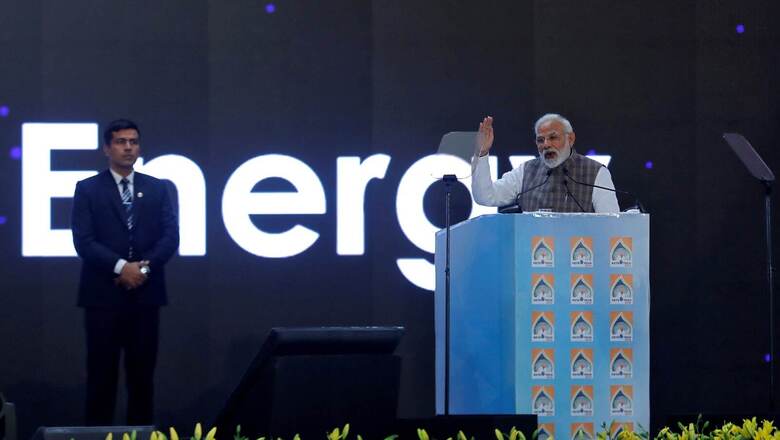
views
In the backdrop of a global fight against climate change, India’s recent announcement of reaching net-zero emissions by 2070 takes a significant position. With the country aiming to meet 50 percent of its electricity needs for renewable energy sources by 2030, it is now a shared responsibility of the government and the people to turn this mission into reality.
Currently, India is the world’s third-largest consumer of electricity, and also became the third-largest renewable energy producer in 2020 after it achieved 38 percent of its energy production capacity (136 GW of 373 GW) from renewable sources alone. The scale of transformation is promising and in line with the country’s economic growth over the past two decades. However, the step, although in the right direction, is also inversely proportional. Due to our increased dependency on coal and oil for industrial growth and modernisation, our annual CO2 emissions have also risen to become the third-highest in the world, making the pathway to net-zero emissions seem distant.
Silver-lining in the midst of smoke?
Even though fossil energy consumption has increased, when calculated based on per person requirement, it is still less than the world’s largest emitters. This is also applicable when considering the true electricity consumption per person.
Prime Minister Narendra Modi’s 2030 goal is to reduce India’s emissions by 45 percent by adding 500 gigawatts of renewable energy generators to the country’s power kitty, thereby reducing almost one billion tonne of our CO2 emissions. These targets, though ambitious, can be easily achieved with a smoother clean energy transition, which is already underway as showcased at the COP21 – Paris Summit.
India has already overachieved its commitment by meeting 40 percent of its power capacity from non-fossil fuels about nine years ahead of the deadline. The significant increase in the use of alternate, and more viable, sources along with technological developments, steady policy support and active involvement of the private sector, will heavily and prominently reflect India’s efforts in producing green energy via solar power plants at a cheaper cost than coal.
Carbon footprint, but smaller
However, these goals come with their own challenges: India is also the world’s third-largest importer of energy. This has led to a sharp rise in the prices of commodities and tighter markets, making energy less affordable. Additionally, our continued dependency on traditional cooking fuels that eventually lead to increasing pollution levels are hurdles we are yet to overcome or circumvent.
While some of these challenges can be tackled by the ongoing policy measures like subsidies on electric vehicles, the rest can be consciously worked on with the financial and technical support contributed towards renewable energy and newer, more advanced, clean energy technologies as advocated in the Union Budget 2022-23.
The Government of India had committed nearly Rs 1.97 lakh crore towards new and renewable energy in last year’s budget as part of its five-year plan. This includes Rs 4,500 crore for ‘High-Efficiency Solar Photovoltaic Modules’. The allocation, however, has now been increased by Rs 19,500 crore for production-linked incentives to boost the manufacturing of high-efficiency modules, prioritising fully integrated manufacturing units into solar PV modules.
The Union Budget 2022-23 is being seen as a massive push toward clean energy transition and one that encourages domestic production of solar power equipment and batteries.
Another step in this direction was the announcement made by Finance Minister Nirmala Sitharaman during her budget speech extending financial support for enabling coal-fired power plants to co-fire biomass pellets at a rate of 5-7 percent resulting in the reduction of greenhouse gas emissions by 38 million tonnes a year annually. It will also provide extra income to farmers, give job opportunities to locals and help avoid stubble burning in agricultural fields. However, this needs adequate and right infrastructure for the states to be able to turn stubble into pellets.
The ongoing policy measures combined with the funding, once fully implemented, could address some of these challenges by accelerating the shift to cleaner and more efficient technologies. While the Centre is putting in extra efforts to push households towards a steady transition away from the use of traditional biomass such as burning wood, India is also laying the groundwork for increasing the use of emerging technologies such as hydrogen, battery storage, and low-carbon steel, cement and fertilisers.
India’s aim of achieving net-zero, however, does not end with reducing greenhouse gas emissions. Its energy transition needs to benefit the people, while also achieving the country’s goal of becoming a global hub for green hydrogen production and exports. Presently, India has the capacity to create a 5 million tonne green hydrogen demand to replace grey hydrogen in the refineries and fertiliser sector. This could potentially result in a reduction of 28 million tonnes of CO2, giving a clear view of securing 400 million tonnes of CO2 abatement by 2050.
As per the IMF’s latest World Economic Outlook (WEO) growth projections released on 25 January 2022, India’s GDP is projected to grow 9 percent in the current and the next financial year, and at 7.1 percent in 2023-24. This projects India as the fastest-growing economy in the world. And if India can achieve net-zero emissions by 2070, it could cement our position as a pioneer of a new economic development model that ditches carbon-intensive approaches and provides a blueprint for other developing economies.
Mr Vaibhav Maloo took over as the Managing Director of Enso Group in 2009 and has been overseeing the group’s business development and strategy. The views expressed in this article are those of the author and do not represent the stand of this publication.
Read all the Latest Opinion News and Breaking News here














Comments
0 comment